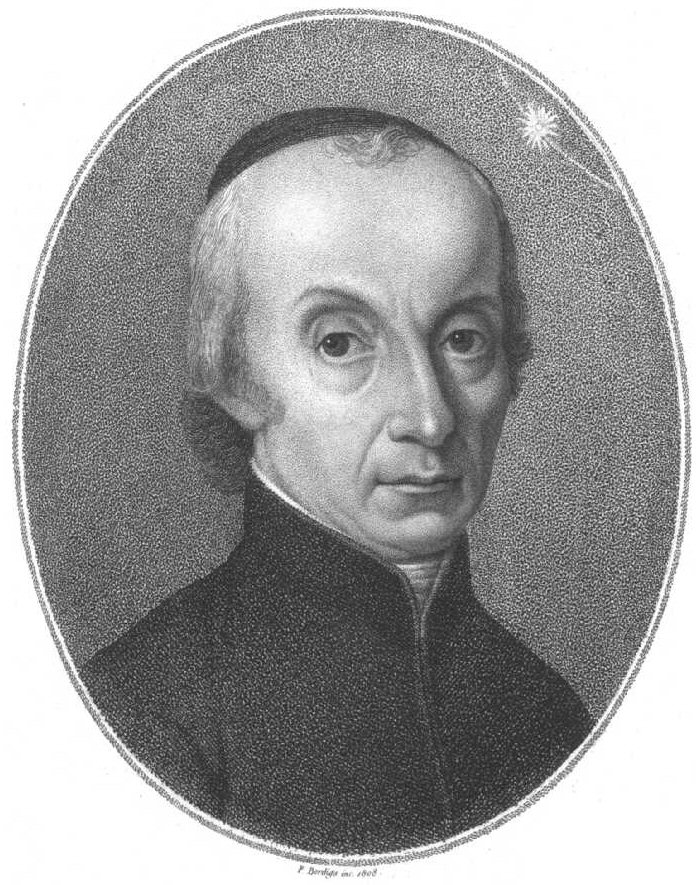- Giuseppe Piazzi
Infobox Scientist
name = PAGENAME
box_width =
image_width =150px
caption = PAGENAME
birth_date =July 7 1746
birth_place =Ponte in Valtellina
death_date =July 22 1826
death_place =Naples
residence =
citizenship =
nationality = Sicilian (Italian)
ethnicity =
field =Astronomy
work_institutions =
alma_mater =
doctoral_advisor =
doctoral_students =
known_for =
author_abbrev_bot =
author_abbrev_zoo =
influences =
influenced =
prizes =
religion =Roman Catholic
footnotes =Giuseppe Piazzi (
July 7 1746 -July 22 1826 ) was an Italian Theatine monk,mathematician , andastronomer . He was born inPonte in Valtellina , and died inNaples . He established an observatory atPalermo , now theOsservatorio Astronomico di Palermo "Giuseppe S. Vaiana" .On
January 1 ,1801 , Piazzi discovered a stellar object that moved against the background ofstar s. At first he thought it was a fixed star, but once he noticed that it moved, he became convinced it was a planet, or as he called it, "a new star".In his journal, he wrote: "The light was a little faint, and of the colour of Jupiter, but similar to many others which generally are reckoned of the eighth magnitude. Therefore I had no doubt of its being any other than a fixed star. In the evening of the second I repeated my observations, and having found that it did not correspond either in time or in distance from the zenith with the former observation, I began to entertain some doubts of its accuracy. I conceived afterwards a great suspicion that it might be a new star. The evening of the third, my suspicion was converted into certainty, being assured it was not a fixed star. Nevertheless before I made it known, I waited till the evening of the fourth, when I had the satisfaction to see it had moved at the same rate as on the preceding days."
In spite of his assumption that it was a planet, he took the conservative route and announced it as a
comet . In a letter to astronomerBarnaba Oriani ofMilan he made his suspicions known in writing:: "I have announced this star as a comet, but since it is not accompanied by any nebulosity and, further, since its movement is so slow and rather uniform, it has occurred to me several times that it might be something better than a comet. But I have been careful not to advance this supposition to the public."
He was not able to observe it long enough as it was soon lost in the glare of the
Sun . Unable to compute itsorbit with existing methods, the renowned mathematicianCarl Friedrich Gauss developed a new method of orbit calculation that allowed astronomers to locate it again. After its orbit was better determined, it was clear that Piazzi's assumption was correct and this object was not a comet but more like a smallplanet . Coincidentally, it was also almost exactly where theTitius-Bode law predicted a planet would be.Piazzi named it "Ceres Ferdinandea", after the Roman and Sicilian goddess of grain and
King Ferdinand IV ofNaples andSicily . The Ferdinandea part was later dropped for political reasons. Ceres turned out to be the first, and largest, of theasteroid s existing within the Asteroid Belt. However, under the terms of a 2006 IAU resolution, Ceres can be called adwarf planet .In 1923, the 1000th asteroid to be numbered was named
1000 Piazzia in his honor. More recently, a largealbedo feature, probably a crater, imaged by theHubble Space Telescope on Ceres, has been informally named 'Piazzi'.References
* cite book
last = Cunningham | first = C. J. | date = 2001
title = The First Asteroid | publisher = Star Lab Press
id = ISBN 0-9708162-2-7
* cite book
author=Foderà Serio, G.; Manara, A.; Sicoli, P.
editor=W. F. Bottke Jr., A. Cellino, P. Paolicchi, and R. P. Binzel
year=2002 | chapter=Giuseppe Piazzi and the Discovery of Ceres
title=Asteroids III | publisher=University of Arizona Press
pages=pp. 17-24 | location=Tucson, Arizona
url=http://www.lpi.usra.edu/books/AsteroidsIII/pdf/3027.pdf
format=PDFExternal links
* [http://www.newadvent.org/cathen/12072d.htm Catholic Encyclopedia entry for Giuseppe Piazzi]
*worldcat id|id=lccn-n87-803467
Wikimedia Foundation. 2010.
